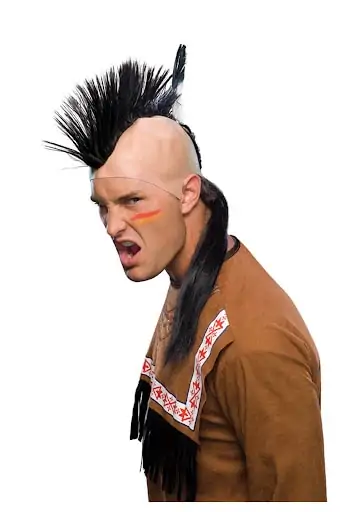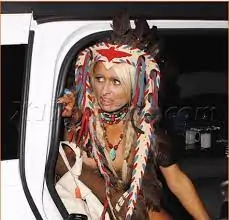Every year, those offensive—sometimes outright racist—Halloween costumes seem to circle back around.
Happy Cultural Appropriation Day!
One of the most common and egregious examples is the “Native American costume” with the person wearing fringe, fake suede, feathers, and braids. Another might be of a “chief” or “warrior.” Oftentimes, these costumes are hyper-sexualized and completely offensive.
These costumes depict indigenous people as a monolith. We are not a monolith.
However, the companies of these big, cheap costume stores take no history or culture into consideration when they push these out of their warehouses and into stores. (Doesn’t it seem like many Native American costumes are modeled off the style of the ghost dance shirt, which is traditionally worn for spiritual protection from violence?)
Over the past few years, online campaigns such as #NotYourCostume and #MyCultureIsNotYourCostume have helped spread awareness. Yet, there's no reason to believe the cringe-worthy tradition won't make its way back around this October 31.
Why is this change so long overdue? And why do companies like Amazon still allow vendors to sell these costumes?
Continue reading to learn more…
The Problem With Cultural Appropriation
Yes, Morris Costumes actually sells a costume called “Pocahottie.”
The unfortunate cultural appropriation—“adoption” of a cultural element by another cultural group—dates back hundreds of years.
The term “cultural appropriation” is often misused and does not refer to someone genuinely trying something from another culture, such as a type of food or music. It also does not include learning about a different culture. What it does mean is when a cultural element, such as a Native headdress, is copied and taken out of context by one or more people within another culture, especially one that is viewed as a majority culture.
Cultural appropriation is harmful and can be seen as exploitative, mockery, and/or desecration.
Within Native communities, it is insulting to see the White culture in America using and misrepresenting elements and symbols of the Native culture—one that was violently taken from them by the same people who are misappropriating these things.
Unfortunately, cultural appropriation began in Native America the second the land was discovered by Europeans and deemed the country “America” and referred to the indigenous people as “American Indians.” And it has just gone downhill from then.
A quote from an article in National Geographic sums it up for us:
“Signs of indigenous culture are ubiquitous in America. But the people they represent are often forgotten.”
After Europeans settled, they realized quickly that “Indian” sells. Images with an Indian on the front of it can be seen from popcorn to soap and toys to malt liquor. The imagery of the Native Americans became ubiquitous. It was (and is) as if “Indian” is a brand that can be marketed and sold by White culture—and therefore trivialized.
This is absolutely what has happened within the Halloween industry, as they make big bucks each October. It is expected that over 10 billion dollars will be spent this Halloween—much of that money going toward the proliferation of cultural appropriation.
Unfortunately, the cultural appropriation toward Native Americans will not cease until enough people (from every culture) stand up and let their voices be heard and actions are noticed that it is not right.
Other Examples of Costumes Guilty of Cultural Appropriation
1. Know of anyone who wants to be a sexy Native warrior? While she is a beautiful woman—nope. Just nope.
2. Why not let the kids join in on the fun of appropriating others’ cultures? Nope.
3. Fellas, want to impress the ladies this Halloween? Well then please don’t dress like this guy.
4. And this may go without saying, but don’t be like Paris Hilton. Wear something else, please.
These cringe-worthy photos say it all—Native Americans are a diverse group of real people still living in the U.S. today—not a smattering of cheap costumes.
The Solution
Thankfully, each and every year it seems like we make more and more progress as more individuals stand up and speak out against this ridiculousness.
Many people, especially those in younger generations, are doing what they can to fight cultural appropriation during Halloween.
A great example of this is through the “We’re a Culture, Not a Costume” campaign that was started in Ohio in 2011 by a group of college students.
Social media hashtags have been popping up left and right over the past few years to show solidarity against cultural appropriation. #NotYourCostume and #CulturalAppropriation are just a few to follow to call someone out or to share examples and explain why they are wrong.
Also, articles like this one from Harvard Crimson help spread awareness to people who may be completely naive and to people who just don’t care—but after reading, just might.
Additionally, you can be counted in the #cultureNOTcostume movement on the Lakota Children’s Enrichment website.
There are many routes you can take to help put a stop to the cultural appropriation of any culture during Halloween and the other 364 days of the year.
How can you help this Halloween?
Make a choice and make a stand to stop buying, selling, marketing, or giving away items that represent someone else’s culture in a way that is disrespectful, mocking, and exploitative.









Running Doe
says:osiyo I agree, they should not dress in our native outfits, to represent who we are not them, it’s sad for them to do that, for that is not who they are,, Running Doe
Kathleen King
says:I agree that belittling another culture or mocking it is wrong, but, especially for those of us who have grown up “around” what I now prefer to label the First Nations, and honor them but are not entitled to be a member, how can we also support the industry. I own tee-shirts and sweatshirts, including the now more than twenty-year old one supporting federal recognition for the Virginia tribes. I have worn moccasins all my life, whether ordered from Canada or purchased at the old Tulsa store. I have the Navajo rugs my grandfather bought in 1925. I go to PowWows, and I commissioned a dance fan from a young man just “learning” how to craft items from his culture. I LOVE the fashions — but how can I legitimately WEAR these things and financially support the artists who craft them now without being deemed an appropriator? Where is the line!
HAWK HOUSTON
says:Let me first state that I am Blackfeet. I am a Half-breed and proud to use that name. I find no insult in being what I am. AS to being offended by the costumes, and so called racism against Native Americans…I lived in the south-west, where we were not even allowed to congregate with so called Americans. That was racism. I am not offended by the costumes..my grandfather a powerful man in his tribe, often told me you can only be offended if you choose to. Hurt feelings never bothered our ancestors. Some would be glad they chose to emulate the greatest peoples on the planet. If you wish to be offended, try the hundreds of broken treaties, the reservations, the fact we were not even citizens until the 20th century. Stuff that matters. People in costumes is a petty and childish reason to be upset. My opinion only matters to me. But, I am proud of what I am. AND chose not to let anyone offend me. MY choice.